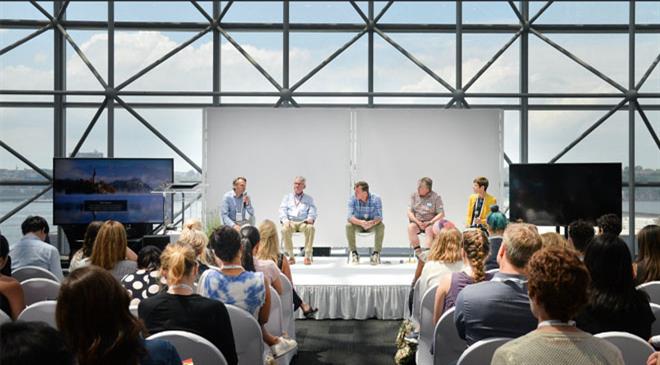TT: Which are the four most widely used performance fabrics in apparel and industrial textiles?
MW: Comfortable, fast drying and natural fabrics are used often in the apparel industry. As the next fairs are the kick-off for Winter 2021/22 collections, waterproof and breathable fabrics for winter sports are very important.
TT: How has the performance fabrics industry evolved? What is the size of the industry?
Steve McCullough: As evidenced by the success of our New York Event, even the most non-functional brands are expanding their assortments to include performance fabrics. Five years ago, this would not have been as prevalent, but now, performance is almost expected in all garments.
Marco Weichert: Performance fabrics are not just sportswear anymore, but a proven development also in the fashion as well as workwear industry.

TT: Which are the biggest markets for performance fabrics products? What are the future applications that you foresee?
MW: The biggest markets are still outdoor, especially winter sports, bike and running, fitness, athleisure and fashion, and definitely workwear. What we experience is that the market for footwear as well as bags is increasing more and more.
SM: Accessories, medical apparel and rehabilitation apparel are interesting new applications, and so is smart-technology apparel.
TT: What is the role of artificial intelligence in functional fabrics? What would be the connect with the Internet of Things (IoT)?
MW: The role of AI is huge and becoming even more important in the future - for example in warming technologies controlled by apps and LED technology for safety lights.
TT: What were the trends in fabric development shown in the latest edition of Functional Fabric Fair with respect to fabric, colour, product, accessories etc?
MW: As the last focus topic at Performance Days, 'The Beauty of Function', has shown, colours, structures, patterns, effects and customised designs of fabrics were more important than ever before. Sustainability is always more than just a trend having the focus on function inspired by nature.
SM: Our New York event uses the tag line, 'Where Function meets Fashion'. I think suppliers are more cognizant that their product is being utilised in more mainstream distribution, and their developments reflect that trend.
TT: What is the focus of Functional Fabric Fair/Performance Days 2019? How many exhibitors are participating this year and what is the footfall expected?
SM: The inaugural Functional Fabric Fair Portland event will have about 125 exhibitors and expecting around 1,200 attendees at the event on October 22 and 23.
MW: Performance Days in Munich will exhibit about 300 international suppliers and expecting around 3,000 attendees from around the world at the upcoming fair on November 13-14.
TT: What will be the key highlights at Functional Fabric Fair/Performance Days 2019?
MW: For Performance Days, the key highlight is the clear commitment on sustainability: Starting with the next fair, only materials that have proven to be sustainable will be featured in the Performance Forum!
SM: For Functional Fabric Fair, we also strive to be the leaders in sustainability not only in promoting companies practicing better ways of producing goods, but also in the way we practice organising events. Our goal is to leave a zero-carbon footprint.

TT: Where is the market for functional fabrics increasing world over? What factors are influencing its market?
MW: In the past, the market itself has been growing slow, but functional fabrics are nowadays a part of everyday urban life used at work -or just in any kind of activity. Functional fabrics are more of a lifestyle now.
SM: Consumers are increasingly seeing the lines blur between function and fashion. People expect their everyday apparel to do something. Stretch, wick moisture, repel water, protect from UV rays, etc. Incorporating these fabrics into everyday life has moved the market in this direction.

TT: What are the ways in which sustainability can be incorporated in performance fabrics?
MW: Brands are looking for functionality without a chemical footprint. For example, hemp is anti-bacterial and coffee yarns have anti-odour functions. Natural materials help to avoid microplastic pollution.
TT: Which industries are the top end-users of functional fabrics? What technologies are widely used in this industry?
MW: The outdoor industry is always on top of new innovations. Long lasting fluocarbon-free water repellant finishes, merino wool, and spacer fabrics.
TT: Do you see the use of green chemistry growing in this industry?
MW: Absolutely, yes.
TT: What are the five latest innovations in this niche?
MW: A few examples of these latest innovations would include Crunch by Polygiene, Polymere dyed fabrics, wood fibres, biobased plastic and hemp.
TT: How competitive is this segment to engage in business?
MW: In my opinion, a focus on green chemistry is the one and only way to stay competitive at all in future! (HO)


